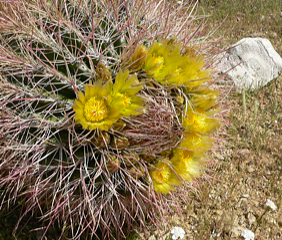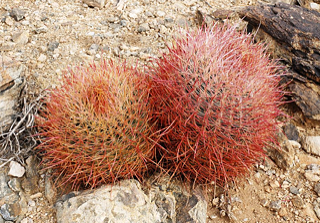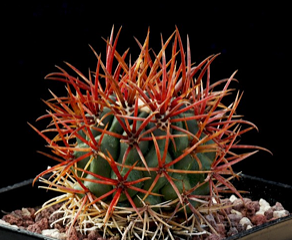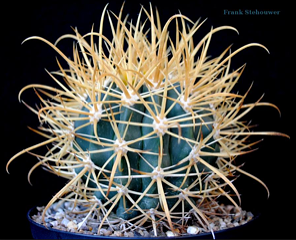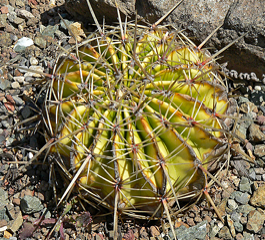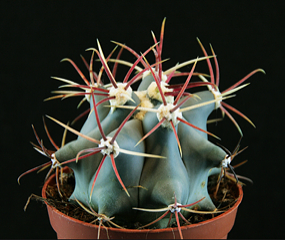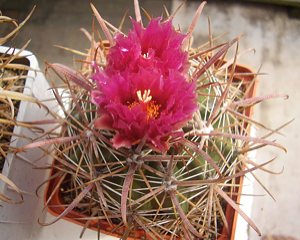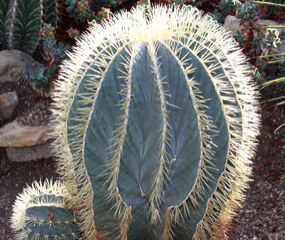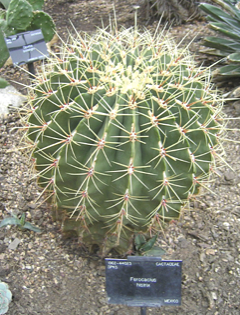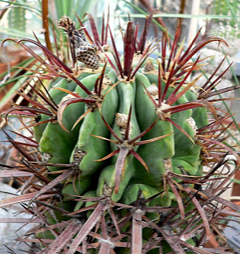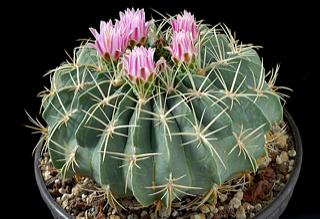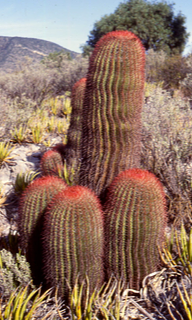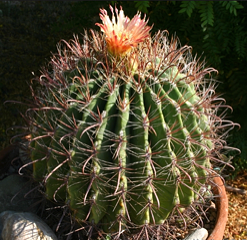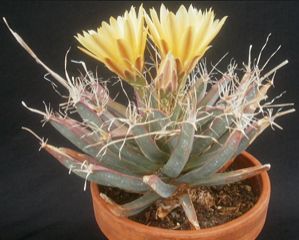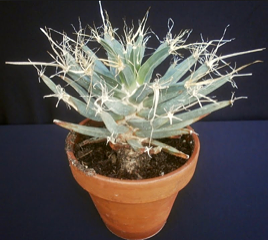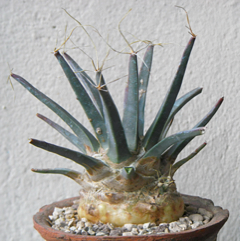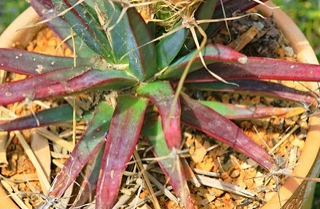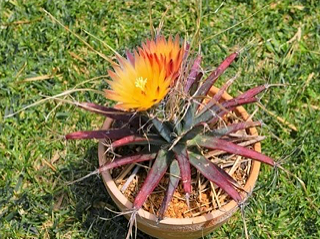Submitted by: Jim Tanner
Ferocactus is a genus of large barrel-shaped cacti, mostly with large spines and small flowers. There are about 40 species included in the genus. They are found in the southwestern United States and northwestern Mexico.
The young specimens are columnar but as they grow older ribs form and they take on a barrel form. Most of the species are solitary but some, form clumps. The flowers are pink, yellow, red or purple depending on the species, and the petals sometimes have a stripe of a darker color.
They are desert dwellers and can cope with some frost and intense heat. The typical habitat is hot and very arid, and the plants have adapted to exploit water movement to concentrate their biomass in areas where water is likely to be present. Ferocactus typically grow in areas where water flows irregularly or depressions where water can accumulate for short periods of time. They are most often found growing along arroyos (washes) where their seeds have been subjected to scarfication due to water movement, but they oddly also tend to grow along ridges in spots where depressions have formed and can hold water for some period of time.
Ferocactus have very shallow root systems and are easily uprooted during flash floods. The “fishhook” spines and the armored web of spines enclosing the cactus body in many species of this genus are adaptations which allow the plant to move to more favorable locations. The seeds germinate in areas where water movement occurs or in areas where standing water accumulates for some period of time, and during flash floods, the hooked spines allow the plants to be caught on waterborne debris, uprooted and carried to areas where water tends to accumulate.
In cultivation ferocactus require full sun, little water, and good drainage. They are popular as houseplants. They cannot tolerate freezing temperatures for extended periods, which typically cause them to yellow, bleach, then slowly die. Propagation is usually from seeds.
Many ferocactus species are ant plants, exuding nectar along the upper meristem from extrafloral nectaries above each areole, and hosting ant colonies.
Leuchtenbergia consists of a single species, L. principis that is quite distinct in shape from every other cactus species. It is immediately recognizable due to its extremely elongated triangular tubercles which reach up to 5 inches in length! These tubercles are arranged in a rosette fashion that is reminiscent of an Agave or Yucca. At the end of each of these tubercles is an areole with long, papery, flexible spines. These spines can exceed 8 inches in length. Flowers come from new tubercles in the center of the plant and are bright yellow and easily exceed 2 inches in diameter.
Leuchtenbergia occurs over a wide range in the Chihuahuan desert of Mexico. It has been in cultivation since the middle 1800’s and is very common in cultivation today. Aside from their very unique growth habit and big yellow diurnal flowers, these plants are are vigorous growers which adds to their popularity.
LATIN LOOKUP – Loquerisne Latine (Do you speak Latin)?
The meanings of latin plant names on this page – from http://davesgarden.com/guides/botanary/
- alamosanus [al-uh-moh-SAY-nus, al-uh-moh-SAH-nus]
Of or from Los Alamos and the Alamos Mountains in Sonora Mexico. - cylindraceus [sil-in-DRAK-ee-us]
Cylinder. - echidne [eh-KID-nee]
From the Greek echidna (snake). - emoryi [EM-or-ee]
Named for William Hemsley Emory, 19th century Army officer and Director of the Mexican Boundary Survey. - Ferocactus [fer-oh-KAK-tus]
From the Latin ferus, (fierce) and cactus, referring to its heavy spines. - fordii [FOR-dee-eye]
1. For Charles Ford, 20th century superintendent of the Hong Kong Botanical Garden.
2. For Lyman M. Ford; no further data available. - glaucescens [glaw-KES-kens]
Becoming glaucous. - gracilis [GRASS-il-is]
Graceful; slender. - hamatacanthus [ham-at-uh-KAN-thus]
From the Greek hamatus (hooked) and Akantha (thorn or spine). - histrix [HiS-triks]
Variant spelling of hystrix, from the Greek word for Porcupine. - latispinus [la-TYE-spin-uss]
Broad spines. - Leuchtenbergia [lewk-ten-BER-gee-uh, lewk-ten-BER-jee-uh]
Named for 19th century Prince Maximillian Eugene de Beauharnais, who was then Duke of Leuchtenberg, Ober-Pfalz (Germany). - pilosus [pil-OH-sus]
Covered in soft, long hair. - principis [PRIN-sip-iss]
Distinguished, noble. - wislizenii [wis-liz-EN-ee-eye]
Named for Frederick Adolf Wislizenus, 19th century German physician and amateur botanist who collected in the southwestern U.S..
